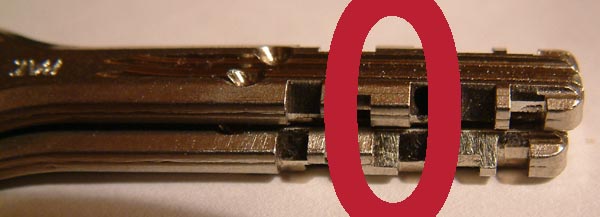
Yesterday Han and myself visited an Abloy service center. This is a
highly restricted area where no strangers are allowed in. But when Han
is in the house all doors open. Especially when he reveals tricks to
them they never heard of before. His knowledge on Abloy is truly
overwhelming and keeps amazing them, over and over and over again.
Yesterday he wanted to know if an asymmetric key pair could be
designed for the Abloy Protec. With asymmetric I mean there is one key
that can only open the lock (only turn counter clockwise), and the
other key can only close the lock (only turn clockwise). A master key
can be cut that will open the lock in both directions.
View the exclusive “behind enemy lines” blackbag video to learn how
individual abloy protec and diskclock keys are cut, and how asymmetric
key cutting for Abloy locks is done.
http://blackbag.toool.nl/video/abloy-keycut.wmv (80 Mb)
You could also use the video to explain people the theory behind
public key cryptography with this video. But you better leave out the
blue key that can both open and close the lock.

Very cool Barry. Another great video demonstration.
It’s an interesting concept, one key that can open and one key that can lock. If you’re the person with the key to lock the door, you better hope you have everything and didn’t forget something inside or you’ll be locked out 🙂
I noticed in the video the keys were color coded. Was that done by the lock guy for just the video are do the keys come colored for left, right or both way keys?
Seanrox: The color coding was done for the video. Before we color
coded them it was very difficult to see the difference between the
keys. So what you see is actually “take two” of the video…
Thanks very much for another very interesting video, Barry. Very cool to hear the different sounds of each cut depth when using the manual Abloy key cutting machine. And fantastic to see the Disklock Pro cutter. I’d love to see inside that machine!
The quality of your video is always really good so I was wondering, what type of camera do you use?
Speaking of public key cryptography, you can see interleaved in the word “Abloy” the first two letters of the names of both Alice and Bob! Not sure what to do with the “y”, though. Perhaps that is for the ‘why are you telling me this?’.
Nice movie! Interesting machinery. But I wonder why the one-way keys are made by changing a 1-cut or 2-cut into a 0-cut. If you do this the other way around (i.e. masterkey has a 0-cut, clockwise key has a 1-cut and ccw key has a 2-cut) you would have two advantages:
1) The lesser keys have less meat than the masterkey. Now they have more, which makes it possible to upgrade your lesser key by filing a 1- or 2-cut from a 0-cut. You can determine which cut to file by the rotation your key is valid for. Also, you don’t have to worry much about ruining your key as you’re filing on the side for which it isn’t valid anyway.
2) Now the system is made up out of 2 discs. When you do it the other way around you only need one disc to achieve this. This frees up the second disc to have all 6 possible cuts, instead of a 1- or 2-cut only. This increases the keyspace again.
This should work, but maybe there is a problem with the different locking bar notch and DBS profile on the 0-disc w.r.t. the 1-6 discs. I might be missing something here. I’ll go and mail Han about this.
all our system keys have an extra 0 cut—-if the lock has to turn both ways we put a 1-2 disc in—-if the master only has to turn both ways we put a 1-6 or 2-6 in —if all keys have to turn both ways we put a 1-2-6 disc in—-in any case all keys can be recut with a 6 if it has to turn both ways——-for disclock pro the 2 would be a 5
Is that the actual machine Abloy sells for cutting Protec keys? I would had thought they would have a fully automated machine.
Very interesting indeed.